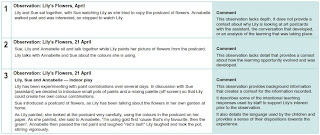Moving from description to analysis
To move beyond description to detailed analysis and interpretation of observation takes time and practice. It also involves developing a strong understanding of the influences that have an impact on teachers’ ways of seeing, interpreting and understanding children’s actions. Rich and effective observations are built on careful attention to both the practical skills involved in recording and the skills of critical self-reflection.
Developing the practical recording skills of specificity, directness, mood and completeness helps teachers produce clear and easily understood observations. The quality and clarity of the observation is particularly important because teachers’ capacity to engage in critical self-reflection depends on effective observation with rich detail. Through critical self-reflection, teachers review their ways of observing and create new possibilities for seeing, interpreting and understanding children’s learning.
Every teacher analyses and interprets what is observed in different ways based on their beliefs and assumptions about teaching and learning, the influence of their teaching experiences and the strong influences of their own childhoods. For example, some teachers may record an observation by describing what they see in a photograph or while observing children, focusing primarily on the physical elements. Others may attend to the social relationships between children, examine how children relate to objects, or use language that reflects their own feelings as they observe children’s interactions.
There is no one way of observing that is "true" or objective, as every individual observes through the lens of their beliefs, experiences and perceptions. However, while observation is never a neutral process, it is essential to critically examine those influences that shape teachers’ ways of seeing and recognise the filters that limit what is seen and how it is interpreted.
Annotated examples
To illustrate the process of moving from description to analysis, three examples are provided of a teacher observation based on one experience in a kindergarten setting. The three examples demonstrate the difference between:
• a simple description of what happened (Example 1)
• a minimal attempt to interpret events (Example 2)
• a detailed description of events with interpretation and analysis (Example 3).
Example 3 clearly links observation, interpretation and analysis to future learning possibilities for children.
Each example is shown first as a simple observation, with comments on its strengths and weaknesses; then as an observation with interpretation and analysis, again, with comments; then once more, as a basis for informed planning. This clearly demonstrates the value of having a rich observation to draw on.
Focus questions
As you read the examples; the following set of questions will help you to examine their quality. The questions will also assist teachers when developing their own observation records. Please consider the attention to detail, the depth of interpretation and the degree of critical reflection that is reflected in the examples.
Observation
• How clear is the observation?
• Does it focus on significant learning?
• Does the observation clearly identify the learning?
• Does the observation provide specific details such as the date, time of day and length of time spent on the learning experience, the learning context in which the observation was made, the number of children and adults involved, and the type of materials and resources used?
• Does it provide information about the non-verbal actions, expressions and gestures?
Interpretation and analysis
• Is it clear how the teacher arrived at this interpretation from the information in the observation?
• Are clear links made to the kindergarten learning and development areas?
• Has the teacher identified whether the learning is in a familiar or new situation and the level of
support the child required?
Learning possibilities
• Do the learning possibilities relate to the observation and significant aspects of learning identified?
• Will the learning possibilities help promote further learning in the targeted area and are they relevant to the child?
After exploring the questions above, consider the critical questions in terms of your own observations.
Critical questions
• What is it about this scenario that drew my interest and why?
• How do my assumptions about children’s social and cultural backgrounds shape what I observe or focus on, as well as how I interpret and record actions?
• How does my social and cultural background influence what I see or don’t see?
• What influences the ways that I prioritise and shape learning opportunities?
Observation and documentation
When you have photographs or artefacts of children’s work, you have a glimpse of the learning that may have taken place. When you include children’s voices and anecdotes you have the beginnings of a valuable observation. When you add interpretation and analysis of the learning taking place, you have substance. Observation with documentation is about substance.
Examples: Observation
Examples: Observation, interpretation and analysis
Reflection questions
What aspects of your practice need further development so that:
• observations are clear and focus on significant learning
• interpretation and analysis align with the observation and make links to the kindergarten learning and development areas
• there is evidence about whether learning occurred in a familiar or new situation, and what degree of support the child required
• learning possibilities relate to the observation and significant aspects of learning
• learning possibilities are relevant to the child and the related learning and development areas. Provided by the QKLG Professional Development Program



No comments:
Post a Comment